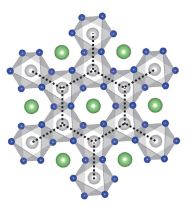Ve spolupráci se zahraničními pracovištěmi nabízí Ústav anorganické chemie následující témata kvalifikačních prací
Dizertační práce
- Teluráty se strukturou včelí plástve / Exploration de tellurates à structure nid d’abeille
Oxidy přechodných kovů se strukturou quiazi-bidimenzionální včelí plástve (obrázek níže) nabízejí pestrou škálu zajímavých magnetických vlastností, které vznikají vlivem defektů v magnetické struktuře, jako například stav tzv. spinového skla nebo kapaliny s kvantovanými stavy.
 Sktrutura s mřížkou ve tvaru včelí plástve (zde H3LiIr2O6)
Sktrutura s mřížkou ve tvaru včelí plástve (zde H3LiIr2O6)
Místo pracoviště: Laboratoire de Cristallographie et Science des Materieux (CRISMAT), Caen, Francie (web: www-crismat.ensicaen.fr)
Termín: Akademický rok 2019/2020
- Magnetismus a foto(elektro)chemie v magnetoelektrických oxidech / Magnetism and photo(electro)chemistry in magnetoelectric oxides / Magnétisme et photo(électro)chimie dans des oxydes magnétoélectriques
The goal of the PhD is to synthesis and to study structures and the properties of oxides belonging to the A2nBnO3+3n formula, with A = a mixed valence transition metal (+2 or +3, such as Fe or Mn) and B = a cation with a +5 (Nb, Ta) or +6 (W, Te) oxidation state. A particular interest will be paid to antiferromagnetic (AF) compounds at low temperature which crystallize – in an inverse-trirutile like structure (n = 1) that may be non-centrosymmetric to give rise to multiferroic properties; or in a corundum type structure (n = 2), as the well-known linear magneto-electric (LME), Cr2O3.
Thus, at least two types of magnetoelectricity exist in this class of materials with a spontaneous electric polarisation (P) (n = 1) or induced a magnetic field H (n = 2).
Apart from magnetoelectrical application that is the capacity to link P (or magnetization M) to H (or E, electrical field), a major issue for memories with 4 sates (P+,P–,M+,M–) for which these compounds could be competitive (the LME coupling coefficient in Co4NbO9 is one of the higher to date), these materials can be used in the energy area to produce H2 via water splitting. Indeed Bi2WO6 or Fe2WO6 rutiles are reported as exhibiting photo(electro)chimical (PEC) properties in link with their band structure well adapted to involved energies. More recently, the increase of such effect induced by electrical polarisation was evidenced in ferroelectrical materials.
The PhD challenge is to prepare metal transition oxides and to characterize their ME et LME properties in order to control P by application of H/E and thus to study the ME/PEC coupling.
Program
The first step is devoted to the synthesis using different methods of compounds, isotypes of already known oxides in the n = 1 and 2 series but also in exploratory research. To establish structures/properties relationships, crystalline and magnetic structures will be studied and link to electrical {and ME[P(H)]} as well as magnetic {and [M(E)]} properties.
Compounds showing a band gap suitable to water splitting will be studied by PEC, and more specifically in link with the monitoring of the spontaneous or induced electrical polarization.
Venue: Laboratoire de Cristallographie et Science des Materieux (CRISMAT), Caen, Francie (web: www-crismat.ensicaen.fr)
Period: since year 2018
